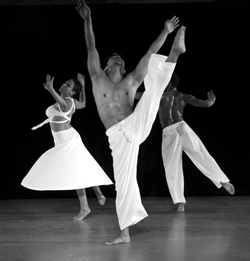Ronald K. Brown and 20 years of convincing, uplifting evidence
By Gus Solomons jr.
Ronald K. Brown is a “post-emerging” choreographer—he’s created works for Ailey—with a truly distinctive movement language that is not only kinetically infectious but also highly expressive emotionally. His mission, telling stories that reflect on African-American culture and history, and personal and spiritual identity, has earned his Evidence Dance Company a large, enthusiastic following. The troupe celebrated its 20th year in a Joyce Theater season with six dances from 1998 to 2005 on two different programs. Refreshingly, no premieres siphoned attention from enjoying Brown’s body of seasoned works.
The newest work, seen on Program A, “Order My Steps” (2005) was inspired by the idea of losing one’s way in life, then finding salvation in the biblical Psalm 119, “Make me go in the path of thy commandments for therein do I delight with my whole heart.” Typical of Brown’s craft, the dance combines text passages—here spoken onstage by Chad Boseman—with movement that fuses Afro-Caribbean, disco/club, body vernacular from Harlem streets, and modern dance, set to a varied selection of music from Bob Marley’s reggae to contemporary concert works by Terry Riley and Fred Hammond.
Three lost souls, lanky Juel Lane, fiery Shani Nwando Ikerioha Collins, and fabulous, full-bodied Tiffany Jackson, hurl their athletic limbs angrily, lit by diamond-shaped patches of light in Dalila Lee’s offbeat lighting plot. In colorful encounters, they revile, reject, and then are embraced by an exuberant community of four—Camille A. Brown, Arcell Cabaug, Bridget Moore, and Keon Thoulouis, spectacular performers all.
The jaggedly individual movement of the rebellious trio is set in counterpoint to the mostly unison quartet. Revelatory solos eventually bring the disaffected threesome into accord with the happy community of four. Brown’s knack for selecting soul-stirring, rhythmic music, to which to set his long, syncopated African-esque phrases—rich with dynamic changes and unexpected pauses—helps fire our kinesthetic spirits while capturing our emotions.
Next, “Walking Out the Dark” (2002) remains one of Brown’s most simply structured and powerful dances. Four people stand at the corners of Brenda Gray’s lighted square—a metaphoric boxing ring—where intense confrontations occur between pairs of combatants. When premiered, the work featured rotating, gender-neutral casts; here Brown uses two men and two women (Cabaug, Lane, Camille Brown, and Collins).
Wearing simple brown-toned garments by Meckha Cherry, the dancers face off in the squared circle to music by Philip Hamilton, Sweet Honey in the Rock, and Francisco Mora. They challenge each other with violent gesturing, perilously close to each other but never touching until near the end, when pairs press crowns of their heads together like fighting bulls. Despite the ferocity of their encounters, they reach an accord at the end, as each falls prostrate, exorcised.
Finally, the 1999 “Grace,” originally commissioned by the Alvin Ailey American Dance Theater, closes the program on an uplifting spiritual note. Moore, in a long white gown that reveals her strong back and abs, begins in a shaft of light upstage center, the divine high priestess of some sacred place. After her stirring solo, four dancers dressed in vivid red and three more, including Mr. Brown, in white (costumes by Wunmi Olaiya), engage in the struggle of good over evil, dancing to the pulsing music of Duke Ellington, Roy Davis Jr., and Fela Anikulapo Kuti—one of Brown’s favorite music sources.
Eventually, all the dancers, now in white, proceed formally into the “temple” of light at Moore’s powerful command. The audience’s frequent shouts of approval for individual dancer’s efforts gave the concert the flavor of a revival meeting, and the final ovation affirmed Brown’s ability to rouse deep emotion with honest, morally committed, and kinetically thrilling dances.
gaycitynews.com


































